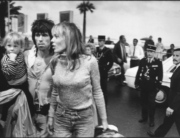![]() This experimental documentary by director Jack Hazan has been restored for audiences to appreciate 45 years after its original release. Predating reality TV, Hazan sheds the talking head trope of documentaries and instead frames a narrative of three years of painter David Hockney’s life by having the subject, his friends, and professional partners reenact moments in improvised scenes. As a result, the documentary feels like a dramatic film.
This experimental documentary by director Jack Hazan has been restored for audiences to appreciate 45 years after its original release. Predating reality TV, Hazan sheds the talking head trope of documentaries and instead frames a narrative of three years of painter David Hockney’s life by having the subject, his friends, and professional partners reenact moments in improvised scenes. As a result, the documentary feels like a dramatic film.
It’s a feat of visual storytelling. Viewers are not told through exposition who these people are; they’ll have to piece together the relationships as the movie goes along, which gives viewers a lot more credit than most documentaries that lay out all of the relationships for them. Hazan’s approach is much more novelistic in this way.
We start by seeing repeated scenes of Hockney (bleach blond, thick black circular glasses, almost like a caricature of an early 1970s artist) lounging on sofas with friends. At first, the conflicts in the story line dawdle on matters like, “Should I go to California or New York?” and come off like the kinds of conversations one might prejudicially imagine snobby art world folk having. But the film begins to deepen as one of Hockney’s real-life friends says, and then reiterates later, the film’s theme, “When love goes wrong, more than two people suffer.” But what kind of love are we talking about?
The exact story is murky because we have to piece it together, but the major focus would appear to be that Hockney has a cheating boyfriend (model and art student Peter Schlesinger), or that the affair has recently come to its end. How will this breakup affect the painting he is currently trying to perfect, which is supposed to depict the very man who just left him?
But the story is also about Hockney’s art dealer, who depends on the artist for his livelihood. Do all the people who surround Hockney, be they transitory or permanent, function to support his perfectionism? While he is going through a phase of depression, he decreases his output, now finishing only six paintings per year. But who’s to say when a work is finished and how many creations an artist must create in any given time span? These are the questions at hand in A Bigger Splash, and it should be a crash course for anyone aspiring to become a commercial artist.
There is an ominous tone throughout, given that Patrick Gowers’s score sounds like the music from the horror movies of the time, The Omen and Rosemary’s Baby. You keep expecting something terrible to happen, and, of course, by the end many things occur to these real-life figures, but just because a baby isn’t born with demonic pretenses doesn’t mean the repercussions here aren’t detrimental.
The style throughout is surreal. Hazan even goes so far at one point to re-create a dream of Hockney’s, full of symbolism. And there are the homoerotic scenes (some foreplay is shown), which are leant an air of surrealism throughout. Although Hockney does not participate in this scenes (though he and almost the entire male cast have full-frontal nude scenes), we see his ex-lover Schlesinger engage in a couple of erotic moments that are either real or happening in Hockney’s jealous mind.
Now that it’s been restored and will be given a limited release (and we can hope streaming distribution), A Bigger Splash is a documentary way ahead of its time that has yet to be surpassed for its hybridity. See this film and you will wish there were more documentaries like it. And just a final FYI, the painting Hockney worked on during this film, Portrait of an Artist (Pool with Two Figures), sold for $90.3 million in 2018, setting a record for a living artist.







Leave A Comment